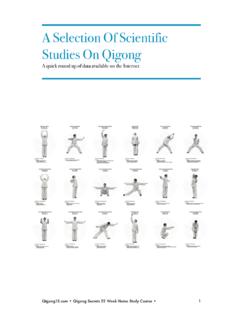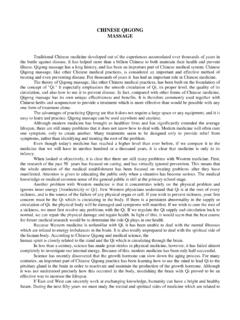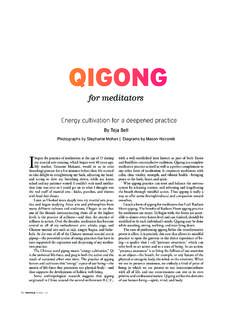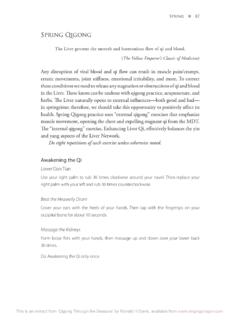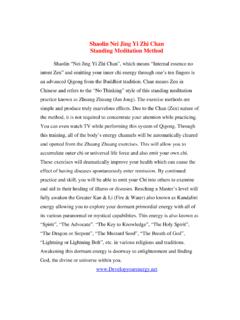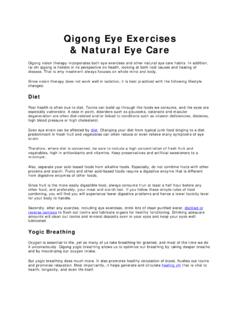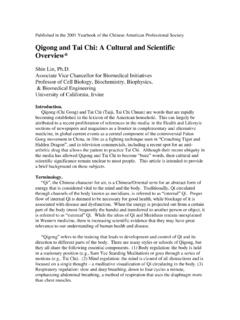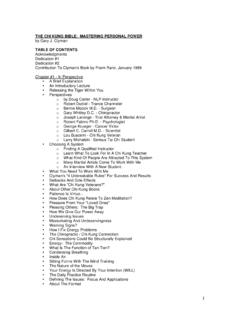Transcription of LUOHAN GONG. Shaolin Internal Training Set.
1 2 Huang Han Xun LUOHAN gong Shaolin Internal Training Set Copyright Shaolin Kung Fu OnLine Library Published by Shaolin Kung Fu OnLine Library Huang Han Xun LUOHAN gong Translation: Wang Ke Ze Leonid Serbin Editor: Andrew Timofeevich 2006 3 About Author The "Mantis King" Huang Han Xun was born in Guangdong province, Shun De county. He joined the Hong Kong Jing Wu Association in 1932 and began his instruction under shifu Luo Guang Yu. Apparently, shifu Huang Han Xun worked as a janitor in the Jing Wu association, therefore as an employee of the place, shifu Huang had the ability to take classes taught by instructors of various styles. At the age of twenty he was encouraged by shifu Luo Guang Yu to establish a school in Macau. He then went to Hankou to teach at the Hankou Jing Wu Association branch.
2 Shifu Huang Han Xun was asked by shifu Luo Guang Yi (who was teachig at the Hong Kong Jing Wu) to go to Wuhan, Szechaun province to teach at the Ching Wu branch there. Throughout his long teaching career, shifu Huang Han Xun published over forty volumes on the northern praying mantis kung fu system. These would serve to be a guide for future generations of the northern praying mantis system. Shifu Brendan Lai says that shifu Huang Han Xun wished to spread mantis and share as much of the art as he knew with the world freely. He felt that the best way to preserve the theories and techniques was to openly share them with everyone. His death in 1973. 4 History of Creation of Book LUOHAN gong The history of the creation of this book goes back to Master Fan Xu Dong (life time: 1841 1925, according to another data - 1936). At the turn the 19-th and 20-th century Fan Xu Dong several times visited Shaolin Temple where he studied heritage of the monastery.
3 That s what Master Jon Funk writes about it: Fan made several trips to the Shaolin temple and spent time there researching with the monks. From these trips to the Shaolin temple, as well as his other work with the Seven Star Praying Mantis system, he wrote five volumes titled "The Shaolin Authentic". These handwritten manuals contained concepts on fighting skills, medical information and historical aspects of kung fu. Contained in one of these five volumes is the eighteen exercises of the LUOHAN gong complete with replicas of the original drawings of the Shaolin monks demonstrating the postures of each exercise. These five books were later hand copied in Hong Kong by shifu Huang Han Xun. The original illustrations and calligraphy on LUOHAN gong by shifu Fan Xu Dong was reproduced in shifu Huang's book in which he added photographs to depict the movements.
4 5 Contents Form I. XIAN REN gong SHOU The Saint Hermit Greets. Position 1. Arms are let down along the body, feet are set together. Position 2. Turn over hands and raise a tripod with power of QI. Position 3. Bending in the waist and stooping forward. Position 4. Turn your face up, bend yourself back in the waist and stick out the stomach. Form II. BA WANG JU DING The Great Prince Raises a Tripod. Position 1. Hands divide water into two streams, legs are filled with strength. Position 2. Mighty eagle spreads its wings. Strain power of the whole body. Position 3. To divide the position with a pair of beetles, saddle a horse and jump up the saddle. Position 4. To lift a club weighing 1000 JINs and mount a horse. Position 5. To present the moon on a gold tray. Strain power of the whole body. Form III. JUO YU CHA HUA To Stick Flowers to Left and Right. Position 1. Hands in the initial position at the waist, feet are set together.
5 Position 2. The Saint Hermit shows the road. Position 3. To raise arms above the head and to strain the stomach. Position 4. To encompass ribs with a hook from below, to bend the leg in knee, to raise up the toe. Position 5. Cross arms, reap the fruits of your efforts, raise QI. Form IV. KU SHU PAN GEN - Intertwined Roots of a Dry Tree. Position 1. The Rhinoceros looks at the moon. To bring forward palms. Position 2. The hawk turns in its nest. Position 3. To fish out the moon from the sea bottom. To bend legs in knees, to sink the waist. Position 4. Bring palms with their back toward you forward and complete this form. Form V. YE CHA TAN HAI - The Devil Measures Sea Depth. Position 1. To raise a tripod with one arm. Position 2. To bend in the waist and touch the ground with hand. Position 3. One blow in store behind the back. Position 4. To take water with cupped hands. 6 Form VI. TUI CHUAN LIANG GE To Fling the Window Open and Let Light In.
6 Position 1. A turn to both sides. Position 2. To push a mountain, to catch a tree. Position 3. To drag a net by the force of legs. Position 4. To put palms toward the wind. Form VII. WEI TUO XIAN CHU Wei Tuo Presents a Club. Position 1. Bring arms to sides in front of the breast. Position 2. Er Lang carries a mountain on a yoke. Position 3. To put hands together and raise up a tripod. Position 4. To finish the exercise in the rider s stance. Form VIII. LAO SENG RU CHAN The Old Monk is Deep in Meditation. Position 1. To tame the Dragon and Tiger. Position 2. To stretch out the groin and chop in wrath. Position 3. Flitting of a pair of swallows. Position 4. To mount a horse. Form IX. TIE NIUGENG DI The Iron Bull Ploughs the Field. Position 1. Counteraction of two forces. Position 2. To divide force among muscles and sinews. Position 3. To clench fist, accumulate force. Position 4.
7 Join palms in front of the face, stand still in a resting position. Form X. QING LONG BAI WEI The Green Dragon Wags its Tail. Position 1. Rest on heel, make a push with arm. Position 2. To swing the whip on horseback. Position 3. Wide stance for all-round defense. Position 4. To repel from the front, to hold back from the rear. Form XI. ZUO YOU PIAN MA To Mount the Horse from the Left and Right. Position 1. To raise up arms, to stand on one leg. Position 2. To prop up an iron gate with knee. 7 Form XII. YAN ZI ZHUO SHUI The Swallow Drinks Water. Position 1. Replacing beams and columns with rotten supports. Position 2. To catch a cicada. Position 3. Make a turn and put arms together. Position 4. The golden cock stands on one leg. Form XIII. HU BEN REN SHEN The Tiger Runs Away from a Deity. Position 1. To run the wind along sides. Position 2. Four supports hang in the emptiness.
8 Position 3. The dead snake lies on the ground. Position 4. Hang a Seal on the breast. Form XIV. CHEN TUAN DA KUN Chen Tuan in an Awkward Situation. Position 1. To plant flowers on the bottom of a well. Position 2. Drilling fist in a position with legs widely set. Position 3. Liu Quan raises up a golden pumpkin. Position 4. Swim in water applying force. Form XV. FU ZI QING LI Farther and Son Ask to Perform the Rite. Position 1. To turn and hit at the middle level. Position 2. To hold a broadsword weighing one thousand JINs. Position 3. To turn and make a push with arms. Position 4. The Great Prince bends his bow. Form XVI. LI YU DA TING The Carp Thrashes and Arches its Back. Position 1. The Yellow Dragon turns over. Position 2. To bend the bow, draw the string and put it in. Form XVII. ZHANG LIAO XIAN PAO Zhang Liao presents a Robe. Position 1. To raise up a knee, to embrace the moon with arms.
9 Position 2. To rest (on ground) with force, bend a knee. 8 Position 3. To hurl a heavy double blow. Position 4. To pull up reins, while sitting on a horseback. Form XVIII. JIN GOU GUA PING Hanging a Jug on a Golden Hook. Position 1. To look at the point of meridians intersection. Position 2. To bend the torso to preserve kidneys. Position 3. Jade pole supports the sky. ** 9 Form I. XIAN REN gong SHOU The Saint Hermit Greets. Original illustrations and calligraphy by shifu Fan Xu Dong. From the manuscript "The Shaolin Authentic". Position 1. Arms are let down along the body, feet are set together. Training method: Stand at attention, set feet together, the toes point forward, let down arms along the body. Clench hands into fists and raise them to the waist level, look straight in the front. Breathing is natural (Photo 1). 10 Position 2.
10 Turn over hands and raise a tripod with power of QI. Training method: Being in the previous position (Photo 1), without changing the position of legs, slowly move fists from the waist forward and upward in front of you. Fists are at the shoulder level, arms are straight. While straightening arms you breathe out (Photo 2). Unclench and straighten fingers of both hands, then slowly bend fingers and clench them into fists again, slowly return hands to the initial position near the waist (Photo 1). At that time draw a breath. Move fists forward again, unclench fingers, then bend them with force and clench into fists again as if you grasp something with hands. Return fists to the initial position as if you pull something toward you. Do the exercise in such a way eight times (straightening and drawing arms is considered one cycle: Photo 1 - 2).
